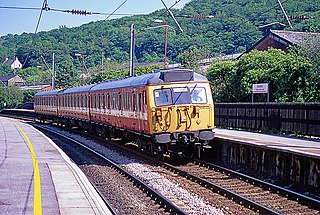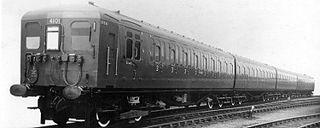
Total Operations Processing System (TOPS) is a computer system for managing railway locomotives and rolling stock, known for many years of use in the United Kingdom.
The Southern Railway created classification and numbering systems for its large fleet of electric multiple units, perpetuated by the Southern Region of British Rail until the early 1980s, when the impact of TOPS was felt. Some stock is still allocated Southern-style classifications in a semi-official manner.

The British Rail Class 423, electric multiple unit passenger trains were mostly built by British Rail (BR) at York Works from 1967 to 1974, although the MBSOs and TSOs of the first 20, 7701-7720, were built at Derby Works. They have manually opening doors next to every seating row and were the last coaching stock built in this pattern for BR. They were mostly found working outer-suburban services in South London and rural services in Kent, Sussex and Hampshire, up to 2005 when they were finally replaced by Electrostar and Desiro units. The fleet had a working life of 38 years.

The British Rail Class 308 alternating current (AC) electric multiple units (EMU) were built by British Railways' Holgate Road carriage works in three batches between 1959 and 1961. They were initially classified as AM8 units before the introduction of TOPS.
A number of different numbering and classification schemes were used for locomotives and multiple units operated by British Railways (BR), and this page explains the principal systems. This section also covers the post-privatisation period, as the broad numbering and classification arrangements have not altered since the break-up of BR.
A number of different numbering and classification schemes have been used for carriages and wagons on Britain's railways, and this page explains the principal systems. Carriages and wagons have frequently had similar arrangements for classification and numbering, so are considered together. There are also links to other pages that deal in greater depth with the particulars of individual types.

The PEP Stock were prototype electric multiple units used on British Rail's Southern and Scottish Regions during the 1970s and early 1980s. They were forerunners of the British Rail Second Generation electric multiple unit fleet. Three units were built, one two-car unit (2001), and two four-car units (4001/4002). Under TOPS, the driving cars were originally classified as Class 461 with the non-driving motor cars as Class 462. They were later reclassified as Class 445 (4PEP) and Class 446 (2PEP).
At the end of the 1960s, British Railways adopted the Total Operations Processing System (TOPS), a computerised system developed by the Southern Pacific Railroad in the United States. All types of locomotive and multiple unit received a TOPS classification, but the first attempt at applying TOPS was soon modified. This page explains the first attempt at using TOPS and cross-refers the classes allocated with those adopted in the successful re-arrangement. An explanation of the final arrangements for TOPS classification may be found here.
The Southern Railway (SR) gave the designations 6 PUL, 6 CITY and 6 PAN to electric multiple units built to work the routes between London and Brighton, West Worthing and Eastbourne. None of these units survived long enough in British Rail ownership to be allocated a TOPS class number. The 6 PUL units were designated 6 COR until 1935.
2-WIM was the designation given, by Southern Railway (SR), to a 4-strong fleet of electric multiple units, dedicated for use on the ex-LBSCR West Croydon to Wimbledon Line, using the headcode 2. None of these units survived long enough in British Rail ownership to be allocated a TOPS class.
The Southern Railway (SR) gave the designation 2-SL to the small fleet of electric multiple units dedicated for use on the South London lines. None of these units survived long enough in British Rail ownership to be allocated a TOPS class. In Southern Railway/Region days, they mainly spent their lives as 2-car units on the ex-LBSCR Wimbledon-West Croydon Line with head code 2. They were distinctive, because they retained their flat roofs over the driving cabs, where the pantographs were originally situated.
The Southern Railway (SR) gave the designation CW to the fleet of AC electric multiple units used on the lines to Coulsdon and Wallington. They were planned by the London, Brighton and South Coast Railway but were delayed by the World War I and the grouping and were introduced by the Southern Railway.

The British Rail Class 419 Motor Luggage Vans were battery electric multiple unit cars built from 1959-61 by BR at Eastleigh Works.

The British Rail Class 220 Voyager is a class of diesel-electric high-speed multiple unit passenger trains built in Belgium by Bombardier Transportation in 2000 and 2001. They were introduced in 2001 to replace the 20-year-old InterCity 125 and almost 40-year-old Class 47-hauled Mark 2 fleets operating on the Cross Country Route. They were initially operated by Virgin CrossCountry and since 2007 have been operated by CrossCountry.

The British Rail Class 319 is an electric multiple unit passenger train built by British Rail Engineering Limited's Holgate Road carriage works for use on north–south cross-London services. These dual-voltage trains are capable of operating on 25 kV 50 Hz from AC overhead wires or 750 V DC from a third rail.

The British Rail Class 310 was a slam-door, alternating current (AC) electric multiple unit (EMU) introduced in 1965 as part of the West Coast Main Line electrification project. They were initially classified as Class AM10 units before the introduction of the TOPS classification system. Constructed at BR's Derby Carriage and Wagon Works. They consisted of four carriages - a second class driving trailer, a second class trailer, a second class motor car and a composite driving trailer. The maximum speed was 75 miles per hour (121 km/h). A glass partition behind the driver's cab enabled passengers in the leading and rear coaches to view the line ahead or behind.

The Alstom Coradia Juniper series is a family of electric multiple unit trains built by Alstom Transport Birmingham for use on the railway network in Great Britain. The family is related to the Coradia 1000 series of diesel multiple units.

The Southern Railway (SR) and the British Railways used the designation Sub to cover a wide variety of electric multiple-unit passenger trains that were used on inner-suburban workings in the South London area. The designation 'Sub' was first officially used in 1941 to refer to newly built 4-car units. However, during the 1940s large numbers of earlier '3-Car Suburban Sets' were increased to four cars by the addition of an 'Augmentation' trailer, and became part of the 4-Sub category. The SR and BR (S) continued to build or else rebuild 4-car units to slightly different designs which became part of the 4-Sub Class. Many of these later examples survived in passenger use until late 1983, by which time British Rail had allocated to them TOPS Class 405.

Network SouthEast (NSE), the sector of British Rail which ran passenger services in London and southeast England between 1986 and 1994, operated a wide variety of rolling stock during its existence. The majority of the network was electrified, and further electrification schemes took place during the 1986–1994 period; and the 7,000 vehicles owned by NSE in 1986 consisted of a mixture of electric, diesel-electric and diesel multiple units, diesel locomotives and the coaches they hauled.














